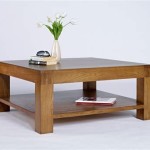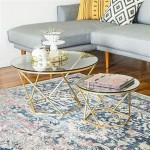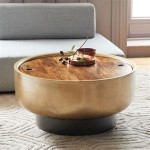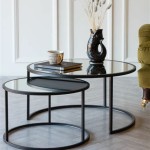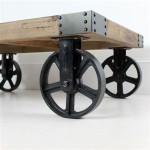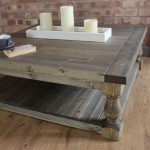How to Paint a Coffee Table in Rustic Style
Achieving a rustic aesthetic on a coffee table through painting involves a deliberate process of distressing and layering techniques. This style aims to evoke a sense of age and history, creating a piece that appears weathered and well-loved. The following guide details the necessary steps and considerations for transforming a standard coffee table into a rustic centerpiece.
The initial stage is preparation. Thorough preparation is crucial for a durable and aesthetically pleasing finish. This encompasses cleaning, sanding, and priming the coffee table surface. Neglecting these steps can result in paint adhesion problems and an uneven final appearance.
To begin, the coffee table needs to be thoroughly cleaned. Remove any existing dust, dirt, or grime using a damp cloth and a mild detergent. For stubborn stains or sticky residue, a degreaser may be required. Allow the surface to dry completely before proceeding to the sanding stage.
Sanding is necessary to create a slightly roughened surface that will allow the paint to adhere effectively. Use a medium-grit sandpaper (around 120-grit) to lightly sand the entire surface of the coffee table. Pay particular attention to any glossy or uneven areas. The goal is not to remove the existing finish entirely, but to create a "key" for the new paint to grip onto. After sanding, remove the sanding dust with a tack cloth or a vacuum cleaner with a brush attachment. A clean surface is imperative before priming.
Priming is often an overlooked step, but it is essential for achieving a long-lasting and even finish. A primer creates a barrier between the existing surface and the new paint, preventing bleed-through and promoting adhesion. Choose a primer that is compatible with both the existing finish and the type of paint to be used. Apply a thin, even coat of primer using a brush, roller, or spray gun. Allow the primer to dry completely according to the manufacturer's instructions, which may involve a specified drying time, often ranging from several hours to overnight. Lightly sand the primed surface with a fine-grit sandpaper (around 220-grit) to smooth out any imperfections before applying the base coat of paint.
Selecting Appropriate Paints and Materials
The choice of paints and materials significantly influences the final rustic look. Consider using chalk paint, milk paint, or acrylic paint, each offering unique characteristics that contribute to the desired weathered effect. The selection should also include appropriate brushes, sandpaper, waxes, and sealers.
Chalk paint is a popular choice for achieving a rustic finish due to its matte texture and excellent adhesion properties. It requires minimal surface preparation and is easy to distress. Chalk paint adheres well to most surfaces, including wood, metal, and plastic. It is also highly porous, which allows for the easy application of waxes and glazes to create depth and dimension. However, chalk paint requires a sealant to protect it from wear and tear, as it is not very durable on its own.
Milk paint offers an authentic, old-world look. It comes in powder form and is mixed with water before application. Milk paint creates a chippy, weathered finish, especially when applied to previously finished surfaces. It is environmentally friendly and non-toxic. However, milk paint can be unpredictable and may require multiple coats for even coverage. A bonding agent may be needed for application to certain surfaces to improve adhesion.
Acrylic paint is a versatile and durable option. While not inherently rustic, it can be manipulated to achieve a distressed look through various techniques. Acrylic paint is readily available, affordable, and comes in a wide range of colors. It is also water-based, making it easy to clean up. However, it typically requires more surface preparation compared to chalk or milk paint, and it may not create the same authentic weathered appearance without additional distressing techniques.
The selection of brushes is vital for achieving the desired finish. For applying base coats, a high-quality synthetic brush or a foam roller is recommended for a smooth and even application. For applying waxes and glazes, a specialized wax brush or a soft cloth is preferred. Stencil brushes can be used for adding decorative elements. Ensure that the brushes are clean and free of debris before each use.
Sandpaper is essential for distressing and creating a worn look. A variety of grits may be needed, ranging from medium-grit (120-grit) for initial sanding to fine-grit (220-grit) for smoothing surfaces and distressing edges. Steel wool can also be used for creating a subtle, aged effect. The grit selection depends on the desired level of distressing.
Waxes and sealers protect the painted surface and enhance the rustic aesthetic. Clear wax is commonly used to seal chalk paint and provide a durable finish. Dark wax can be used to add depth and highlight details. Polyurethane sealers offer a more durable option for protecting the painted surface from scratches and moisture. Consider the desired sheen level when selecting a sealer, as matte finishes tend to complement the rustic style better.
Applying Paint and Distressing Techniques
The application of paint and the implementation of distressing techniques are where the rustic character of the coffee table is developed. This involves layering different paint colors, sanding through layers, and using various tools to create an aged and weathered appearance.
Begin by applying the base coat of paint. Use a brush, roller, or spray gun to apply a thin, even coat of the chosen paint. Allow the paint to dry completely according to the manufacturer's instructions. Depending on the desired coverage, a second coat may be necessary. Ensure that each coat is allowed to dry thoroughly before proceeding to the next step. This step is crucial for preventing the paint from peeling or chipping prematurely.
Once the base coat is dry, consider applying a second layer of a contrasting color. This layer will be partially removed during the distressing process to reveal the base coat underneath. The choice of colors will depend on the desired aesthetic. For example, a dark brown base coat with a cream-colored top coat can create a classic rustic look. Apply the second coat of paint using the same method as the base coat, ensuring a thin and even application. Allow the paint to dry completely before proceeding to the distressing stage.
Various distressing techniques can be employed to create a weathered appearance. Sanding is a common method used to wear away the top layer of paint, revealing the base coat underneath. Use sandpaper of varying grits to achieve different levels of distressing. Focus on areas that would naturally experience wear and tear, such as edges, corners, and high-traffic areas. Apply light pressure and gradually remove the paint until the desired effect is achieved. Avoid sanding too aggressively, as this can create an unnatural look.
Dry brushing is another technique that involves using a dry brush with a small amount of paint to create a textured finish. Dip the tip of a brush into the paint, then wipe off most of the paint onto a paper towel. Lightly brush the surface of the coffee table, allowing some of the base coat to show through. This technique is particularly effective for adding subtle highlights and creating a sense of depth. Experiment with different colors and brushstrokes to achieve the desired effect.
Another method involves using a damp cloth to gently wipe away the top layer of paint while it is still wet. This technique is best suited for chalk paint or milk paint, as they are more porous and easier to manipulate. Use a clean, damp cloth to wipe away the paint in areas where you want the base coat to be visible. This technique creates a soft, subtle distressed effect. Be careful not to remove too much paint, as this can create an uneven appearance.
After the paint is dry and distressed, apply a wax or sealer to protect the painted surface and enhance the rustic aesthetic. Apply a thin, even coat of wax using a wax brush or a soft cloth. Work the wax into the paint, paying attention to details and crevices. Allow the wax to dry for a few minutes, then buff the surface with a clean cloth to create a smooth, polished finish. For a more durable finish, consider using a polyurethane sealer. Apply the sealer according to the manufacturer's instructions, ensuring a thin and even coat. Allow the sealer to dry completely before using the coffee table.
Adding Finishing Touches and Protection
The final step in transforming a coffee table into a rustic style involves adding finishing touches and applying protective coatings. This ensures the longevity of the finish and enhances the overall aesthetic appeal. These touches may include decorative hardware, stenciling, and applying a final protective layer.
Consider adding decorative hardware to enhance the rustic charm of the coffee table. Options might include antique-style knobs, pulls, or hinges. These elements can be strategically placed to accentuate the design and contribute to the overall aged appearance. Ensure the hardware complements the color scheme and distressed finish. Metal hardware with a patina or aged appearance often works well. Attach the hardware securely, ensuring it is functional and aesthetically pleasing.
Stenciling can add intricate details and patterns to the coffee table, further enhancing its rustic character. Choose stencils with designs that complement the overall style, such as floral motifs, geometric patterns, or vintage lettering. Secure the stencil to the surface using painter's tape, and apply the paint using a stencil brush or a foam applicator. Use a light touch to prevent the paint from bleeding under the stencil. Remove the stencil carefully and allow the paint to dry completely. Stenciling can be used to create focal points or to add subtle accents to the coffee table.
A final protective layer is crucial for safeguarding the painted and distressed surface. Depending on the type of paint used and the desired level of protection, options include clear wax, polyurethane sealer, or lacquer. Clear wax is ideal for chalk paint, providing a soft sheen and a tactile finish. Apply the wax using a wax brush or a soft cloth, working it into the paint and buffing it to a smooth finish. Polyurethane sealer offers a more durable barrier against scratches, moisture, and stains. Apply the sealer in thin, even coats, allowing each coat to dry completely before applying the next. Lacquer provides the most durable protection, but it requires professional application and specialized equipment. The choice of protective coating will depend on the intended use of the coffee table and the desired level of durability.

Diy World Market Coffee Table Makeover Liz Marie Blog

Distressed Coffee Table A Revisit Rework The Painted Hive

The Boho Coffee Table Milk Paint Experiment I Re Stuff

How To Refinish A Table Farmhouse Style My 100 Year Old Home

How To Refinish A Rustic Wood Coffee Table With Beautiful Results

Distressed Coffee Table A Revisit Rework The Painted Hive

Farmhouse Coffee Table Makeover

How To Paint A Weathered Wood Finish On Furniture

Rustic Coffee Table Makeover Life On Kaydeross Creek

How To Diy Rustic Slat Table Makeover
Related Posts


